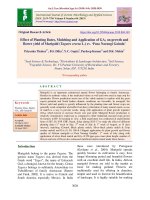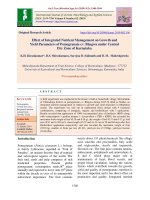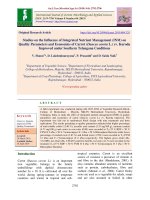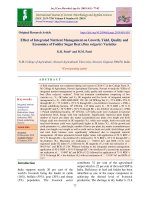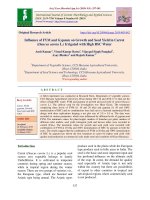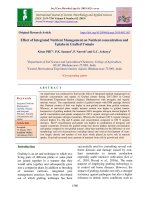Influence of integrated nutrient management on flower and seed yield of African marigold cv. ‘Pusa Narangi Gainda’ during different season in mid hills condition of H.P.
Bạn đang xem bản rút gọn của tài liệu. Xem và tải ngay bản đầy đủ của tài liệu tại đây (248.55 KB, 6 trang )
Int.J.Curr.Microbiol.App.Sci (2019) 8(9): 241-246
International Journal of Current Microbiology and Applied Sciences
ISSN: 2319-7706 Volume 8 Number 09 (2019)
Journal homepage:
Original Research Article
/>
Influence of Integrated Nutrient Management on Flower and
Seed Yield of African Marigold cv. ‘Pusa Narangi Gainda’
during Different Season in Mid Hills Condition of H.P.
Anju Kumari*, B.P. Sharma, Shweta Sharma and R.K. Gupta
Department of Floriculture and Landscape Architecture, YS Parmar University of
Horticulture and Forestry, Nauni, Solan (HP)- 173230, India
*Corresponding author
ABSTRACT
Keywords
Tagetes erecta,
Azotobacter, PSB
(phosphorus
solubilizing
bacteria), PGPR
(Plant Growth
Promoting
Rhizobacteria), AM
(Arbuscular
mycorrhiza), NPK
and FYM
Article Info
Accepted:
15 August 2019
Available Online:
10 September 2019
The present investigation was carried out to find out influence of integrated
nutrient management on flower and seed yield of African marigold cv. ‘Pusa
Narangi Gainda’ during different season in mid hills condition of H.P, at Dr.
Yashwant Singh Parmar University of Horticulture and Forestry, Nauni, Solan, HP
in the year of 2016-2017 during different season (rainy season and summer
season). The experiment was laid out in randomized block design replicated thrice
and with 10 treatments. Study showed significant effect on flower yield per plant
(196.41 g), flower yield per plot (1767.63 g), seed yield per plant (10.88 g) and
seed yield per plot(97.86 g) in plants supplied with Azotobacter + PSB + 70%RDF
(T4). With respect to season, higher flower yield per plant (184.59 g) and
maximum flower yield per plot (1661.27 g) were recorded in plants being grown
during summer season, however more seed yield per plant (17.28 g) and seed yield
per plot (155.52 g) was observed during rainy season planting. Maximum seed
weight of seed per head (0.53 g), highest number of seed per head (186.51 g) and
1000 seed weight (3.37 g) were recorded with (T3) Azotobacter + PSB + 80%
RDF during rainy season planting.
Introduction
Marigold (Tagetes erecta L.) is one of the
most specially grown loose flower crop which
belongs to family Asteraceae. Marigold has
been named after ‘Virgin Mary’. The king
Curtez after conquering Mexico got fascinated
by the beauty of marigold flowers and he
carried it to Spain. It was then offered to the
‘attar’ of Virgin Mary and thus got its name
Mary’s gold which is now popularly known as
marigold (Marshal, 1969). It is documented
that French marigold (Tagetes patula L.) was
put into cultivation in 1573 AD and African
241
Int.J.Curr.Microbiol.App.Sci (2019) 8(9): 241-246
marigold (Tagetes eracta L.) in 1596 AD in
the Europe. In India, these were introduced by
Portuguese between 1502 and 1550 (Gavhane
et al., 2004). Marigold spreads quickly
because of the facts that its cultivation is
relatively easy, it has longer blooming period
and beautiful flowers with a long shelf life.
Also, the marigold flowers are utilized on
commercial scale for different purposes. In
India, about 278 thousand hectares area is
presently under floriculture with a production
of 1656 thousand MT loose flowers annually.
The total area under marigold is 55.89
thousand hectares with a production of about
511.31 thousand MT. In Himachal Pradesh, it
occupies an area of 22 ha with a production
19.61,000 MT (NHB 2016-17). Marigold is
widely cultivated as bedding plant in
landscape design.. The chemical fertilizers are
important sources of nutrients but the
indiscriminate use of chemical fertilizers
poses the threat of environmental pollution
and soil health degradation. At present, we are
not in a position to abandon the use of
chemical fertilizers completely, so the best
option available is to use the biofertilizers in
lesser amounts. Thus, integrated nutrient
management is a strategy for advocating
judicious and efficient use of chemical with
matching addition of organic manures and
biofertilizers. Therefore, emphasis is now
focused on the use of organic manures such as
farm yard manure, and bio-fertilizers like
Azotobacter, Phosphate Solubilising Bacteria
(PSB), AM fungi and PGPR (Plant Growth
Promoting Rhizobacteria). Azotobacter is a
non symbiotic bacterium which fixes
atmospheric nitrogen in to soil (Somani,
2005). Phosphate solublizing organism are not
only able to solubilize insoluble forms of
inorganic P but are also capable to mineralize
organic forms of P, thus improving the
availability of native soil P. Keeping the above
facts in view, the present investigation was
conducted with the objectives of to see the
effect of biofertlizers and its combinations and
to find out appropriate dose of biofertilizers on
flower yield and seed yield during different
season of African marigold respectively.
Materials and Methods
An experiment was conducted at the at the
experimental farm of Department of
Floriculture and Landscape Architecture, Dr.
Yashwant Singh Parmar University of
Horticulture and Forestry, Nauni, Solan, HP in
the year of 2016-2017 to the Influence of
integrated nutrient management on flower
yield and seed yield of African marigold.
African marigold cv. ‘Pusa Narangi Gainda’
was planted during different season i.e. rainy
season and summer season respectively with
the spacing of 30 x30 cm and with 1x 1 m2
plot size during 2016-2017. The experiment
was laid out in randomized block design with
three replications the experiment consisted of
10 treatments viz, T1 100% NPK of RDF, T2
Azotobacter+PSB+90%
(RDF),
T3
Azotobacter+PSB+80%
(RDF),
T4
Azotobacter+PSB+70%
(RDF),
T5
Azotobacter+AM+70%
(RDF),
T6
Azotobacter+AM+80%
(RDF),
T7
Azotobacter+AM+70%
(RDF),
T8
PGPR+90% (RDF), T9 PGPR+80% (RDF)
and T10 PGPR+70% (RDF). The data of both
season were analyzed statistically for
interpretation of results.
Results and Discussion
The pertaining data on flower and seed yield is
presented in Table 1 clearly exhibited,
maximum flower yield per plant (196.41 g)
and maximum flower yield per plot (1767.63
g) recorded in plants grown with T4
(Azotobacter + PSB + 70% RDF), while these
were minimum (127.62 and 1148.54 g,
respectively) with T1 (100% NPK) during
2016-2017. The increased flower production
might be due to that after application of
organic manure and biofertlizers (Azotobacter
and PSB) there was increase in plant growth
242
Int.J.Curr.Microbiol.App.Sci (2019) 8(9): 241-246
as well as number of branches which directly
stimulate flower yield per plant. These results
are in close to conformity with the finding of
Ajitkumar 2002 in Marigold and Maurya 2003
in Tuberose In contrast of season, more flower
yield per plant (184.59 g) and flower yield per
plot (1661.27 g) was noticed during summer
season planting over rainy season planting.
This could be attributed to the existence of
congenial climatic conditions during the crop
growth period and enabled them to produce
increased amount of photosynthates and in
turn resulted in more dry matter accumulation.
Whereas, due to unfavorable climatic
conditions existed during the rainy season
planted crops, it failed to produce optimum
vegetative growth and better flowering.
Similar variation was also observed by
Guruprasad (1999) and Nagarjun et al., (2004)
in China aster; Chanda and Roychoudhary
(1991) in African marigold. The application of
different nutritional treatments significantly
varied the seed yield per plant over the (5.86
g) T1 i.e.100% NPK. Among these treatments,
seed yield per plant (10.88 g) and seed yield
per plot (97.86 g) to be recorded more with T4
(Azotobacter + PSB +70% RDF) as compared
to T1 (100% NPK), which might be due to the
fact that beneficial effect of nitrogen (from the
Azotobacter) and phosphorus (from PSB) on
flower size and weight of individual flower
attributed to increase the protein synthesis,
thus promote the development of floral
primordial, while phosphorus was found to be
involved in formation of floral primordial
resulting in more number of flowers obtained
which directly affect the seed yield per plant.
Table.1 Influence of integrated nutrient management on flower and seed yield of African
marigold during different planting seasons
Treatments
Flower yield per plant (g)
T1
Rainy
Season
103.81
Summer
Season
151.42
T2
160.08
T3
Summer
Season
1362.81
Mean
127.62
Rainy
Season
934.26
184.31
172.20
1440.75
166.51
194.28
180.40
T4
179.02
213.79
T5
157.49
T6
Seed yield per plant (g)
Summer
Season
2.62
Mean
1148.54
Rainy
Season
9.10
1658.76
1549.76
12.33
1497.96
1748.55
1623.26
196.41
1611.18
1924.08
183.42
170.46
1417.38
165.78
189.79
177.79
T7
172.97
210.44
T8
154.93
T9
T1
Mean
CD0.05
Mean
Flower yield per plot (g)
Seed yield per plot (g)
Summer
season
23.58
Mean
5.86
Rainy
season
81.87
4.22
8.28
110.97
37.98
74.48
14.74
4.27
9.51
132.66
38.40
85.53
1767.63
17.28
4.47
10.88
155.52
40.20
97.86
1650.75
1534.07
12.23
3.96
8.10
110.10
35.64
72.87
1492.35
1708.11
1600.23
13.64
4.26
8.95
122.79
38.34
80.57
191.71
1556.76
1893.93
1725.35
15.20
4.34
9.77
136.77
39.06
87.92
181.85
168.39
1394.40
1636.68
1396.19
12.06
3.77
7.92
108.54
33.90
71.22
130.50
155.33
142.92
1186.47
1397.97
1411.58
9.77
3.10
6.44
87.96
27.87
57.92
135.53
181.24
158.39
1219.74
1631.13
1425.44
11.67
3.47
7.57
105.03
31.26
68.15
152.80
184.59
168.70
1375.15
1661.27
1518.20
12.80
3.85
8.33
115.22
34.62
74.92
Season
: 3.10
Treatments
: 6.94
SeasonxTreatments : 9.82
Season
: 28.05
Treatments
: 62.71
SeasonxTreatments : 88.69
243
Season
: 0.81
Treatment
: 1.80
SeasonxTreatment : 2.54
52.73
Season
: 7.27
Treatment
: 16.26
Season xTreatments:23.00
Int.J.Curr.Microbiol.App.Sci (2019) 8(9): 241-246
Table.2 Influence of integrated nutrient management on seed attributes of African marigold
during different planting seasons
Treatments
Number of seed per head
Weight of seed per flower (g)
1000 seed weight (g)
Rainy
Summer
Rainy
Summer
Rainy
Summer
Season
Season
Season
Season
Season
Season
T1
172.66
68.40
120.53
0.43
0.15
0.29
2.69
2.59
2.64
T2
251.06
86.43
168.75
0.67
0.21
0.44
2.91
2.82
2.87
T3
280.68
92.33
186.51
0.84
0.22
0.53
3.42
3.32
3.37
T4
260.47
106.69
183.58
0.73
0.25
0.49
3.41
3.30
3.36
T5
242.17
88.58
165.38
0.63
0.22
0.43
3.23
3.27
3.25
T6
233.84
75.07
154.46
0.61
0.20
0.41
3.20
3.23
3.22
T7
266.10
102.18
184.14
0.79
0.24
0.52
3.32
3.29
3.31
T8
191.39
69.04
130.22
0.51
0.16
0.34
2.78
2.70
2.74
T9
212.29
70.22
142.26
0.58
0.19
0.39
2.83
2.75
2.79
T10
205.84
70.65
138.25
0.57
0.19
0.38
2.83
2.75
2.79
Mean
230.65
82.16
155.20
0.64
0.20
0.42
3.06
3.00
3.03
CD0.05
Season
: 5.46
Season
Season
: 0.05
Treatments
: 12.44
Treatment
: 0.09
Treatment
: 0.12
SeasonxTreatment
: 17.60
Season xTreatment
: 0.12
Season xTreatment
: NS
Mean
The similar results were recorded by Singh et
al., (2015), Yadav et al., (2017) and
Chandrikapure et al., (1999) in African
marigold. In general, seed yield per plant and
seed yield per plot was higher in rainy season
(12.80 g and 115.83 g, respectively) over
summer season, which might attributed to
there was lesser activity of pollinators during
seed setting as well as shedding of seeds due
to heavy rains at the time of harvesting during
summer season planting as it is evident from
meteorological data. These results are in the
close conformity with the findings of Meena
et al., (2015) and Singh and Arora (1998) in
African marigold. As evident from Table 2,
more number of seeds per head (186.51)
noticed with the application of T3,
(Azotobacter + PSB + 80% RDF), while it
was less (120.52) with T1 (control)..
Mean
: 0.04
Mean
Maximum seed weight per head (0.53 g) was
obtained with T3 (Azotobacter + PSB + 80%
RDF), however it was minimum (0.29 g) in
plants grown with T1 (100% NPK), which it is
ascribed to the better quality in flower
production traits by using chemical, manure,
Azotobacter and PSB, which increased the
nutritive status of macro and micro nutrients
in soil.. The similar findings were also
reported by Singh et al., (2015) in marigold
cv. ‘Pusa Bsanti’ and by Bower et al., (1965)
in petunia. Rainy season planting exhibited
more number of seeds (230.65) per head, seed
weight per head (0.64g) and 1000 seed weight
(3.06 g).however,1000 seed weight was
recorded more (3.37 g with T3 (Azotobacter +
PSB + 80% RDF). Similar results were also
reported by Meena et al., (2015) in African
marigold.
244
Int.J.Curr.Microbiol.App.Sci (2019) 8(9): 241-246
mulches on growth, flower quality and
yield of marigold (Tagetes erecta L.)
cv. ‘Pusa Narangi Gainda’. The Orissa
Journal of Horiculture 32(1): 35-37.
Guruprasad, G.1999. Effect of time of
planting on growth flowering and vase
life studies in China aster (Callistephus
chinensis Nees). M.Sc. (Agri.) Thesis,
University of Agricultural Sciences,
Dharwad.
Marshal, C. 1969. Encyclopedia of
Gardening. Paul Hanyla, London. 20:
2213-2214.
Maurya, P.R. and Beniwal, S.V. 2003. Use of
bio-fertilizers in horticulture crops.
News Letter Agriculture and Biological
Sciences 1: 12-13.
Meena, Y., H.S. Sirohi, B.S. Toma, and
Kumar, S. 2015. Effect of planting time,
spacing and pinching on growth and
seed yield traits in African marigold
(Tagetes erecta L.) cv. ‘Pusa Narangi
Gainda’. Indian Journal of Agricultural
Sciences 85(6): 797–801.
Nagaraju, D., B.S. Reddy, R.T. Patil, P.M.
Gangadharappa and Kulkarni, B.S.
2004. Effect of dates of planting on
flowering and flower quality of China
aster (Callistephus chinensis Nees.) cv.
‘Kamini’. Journal of Ornamental
Horticulture 7(3-4): 132-134.
Singh, J. and Arora, J.S. 1988. Effect of
planting times and spacing on growth,
flower and seed production of marigold
cv. ‘African Giant Double Orange’. The
Punjab Vegetable Grower 23: 41-44.
Singh, K., U. Kumar and Kumar, A. 2015.
Effect of planting date and spacing on
performance of African marigold
(Tagetes erecta L.) cv.‘Pusa Narangi’
under North Bihar agro-ecological
conditions. International Journal of
Forestry and Crop Improvement 6(1):
16-20.
Singh, L., P.K.S. Gurjar, A.K. Barholia,
Haldar and Shrivastav, A. 2015. Effect
Interaction effect
Interaction between season and treatments
exhibited that that plants grown during
summer season produced more flower yield
per plant (196.41 g), flower yield per plot
(1767.63 g) in plants grown with T4
(Azotobacter + PSB + 70 %RDF) during
summer season, while these were higher
(17.28, 155.52 g respectively) in plants being
grown in rainy season with the same
treatment (T4). More number of seed per head
(280.68), highest seed weight per head (0.84
g) and maximum 1000 seed weight (3.37)
were recorded with the application of T3
(Azotobacter + PSB + 80 %RDF) during
rainy season.
References
Ajitkumar. (2002). Effect of organic and
inorganic fertilizers on growth, yield
and post harvest life of marigold. M.Sc.
(Agri.)
Thesis,
University
of
Agriculture
Science,
Bangalore
/>Anonymous. 2016. National Horticulture
Board. Department of Agriculture and
Coperation, Government of India.
Retrieved from www.nhb.gov.in.
Chanda, S and Roychaudhary, N. 1991. The
effect of planting dates and spacing on
growth, flowering and yield of African
marigold (Tagetes erecta L.) cv.
‘Siracole’. The Horticulture Journal
4(2): 53-56.
Chandrikapure, K.R., K.T. Sadawrte, D.M.
Panchbhai and Shelke, B.D. 1999.
Effect of bioinoculants and graded
doses of nitrogen on growth and flower
yield of marigold (Tagetes erecta L.).
Orissa Journal of Horticulture 27(2):
31-34.
Gavhane, P.B., V.N. Kore, A.J.Dixit and
Gondhali, B.V. 2004. Effect of graded
doses of fertilizers and polythene
245
Int.J.Curr.Microbiol.App.Sci (2019) 8(9): 241-246
of organic manures and inorganic
fertilizers on growth and flower yield of
marigold (Tagetes erecta L.) cv. ‘Pusa
Narangi Gainda’. Plant archives 15(2):
779-783.
Somani,L.
L.
2005.
Handbook
of
Biofertilizers. Agrotech Publishing
Academy, Udaipur. 1167p.
Yadav, K.S., A.K. Pal, D.Yadav and
Mauriya, S.K. 2017. Influence of
different
biofertilizers
and
its
consortium on growth, flowering and
seed yield of marigold. International
Journal of Pure & Applied Bioscience
5(6): 1660-1665.
How to cite this article:
Anju Kumari, B.P. Sharma, Shweta Sharma and Gupta, R.K. 2019. Influence of Integrated
Nutrient Management on Flower and Seed Yield of African Marigold cv. ‘Pusa Narangi
Gainda’ during Different Season in Mid Hills Condition of H.P. Int.J.Curr.Microbiol.App.Sci.
8(09): 241-246. doi: />
246
